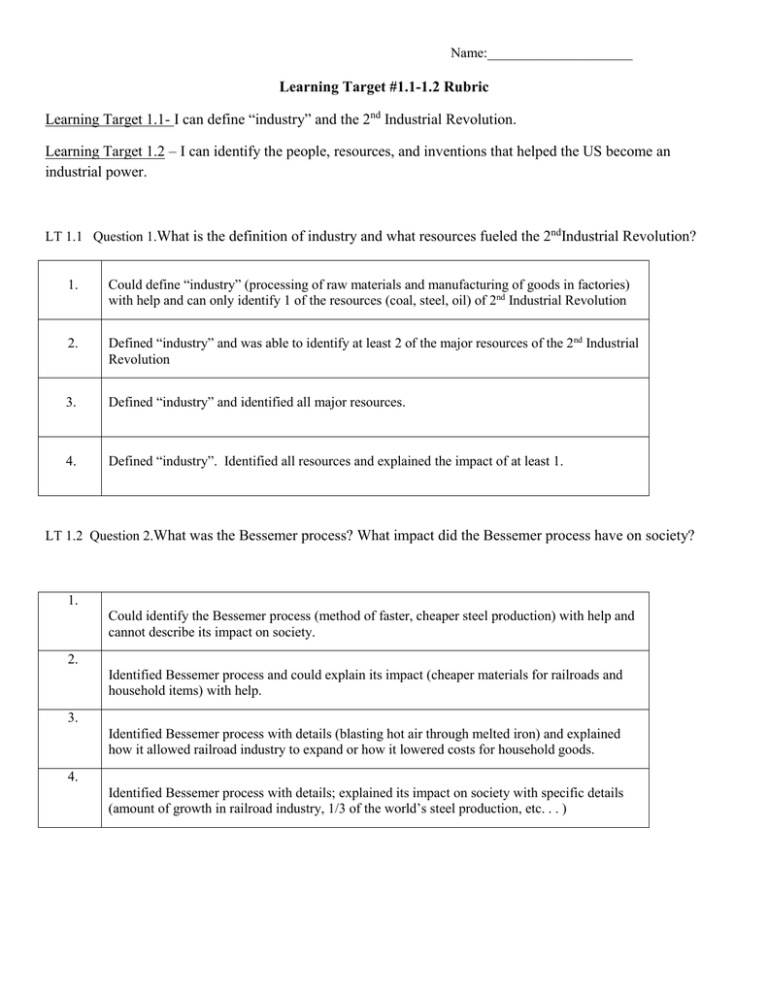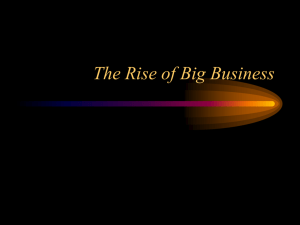File
advertisement

Name:_____________________ Learning Target #1.1-1.2 Rubric Learning Target 1.1- I can define “industry” and the 2nd Industrial Revolution. Learning Target 1.2 – I can identify the people, resources, and inventions that helped the US become an industrial power. LT 1.1 Question 1.What is the definition of industry and what resources fueled the 2ndIndustrial Revolution? 1. Could define “industry” (processing of raw materials and manufacturing of goods in factories) with help and can only identify 1 of the resources (coal, steel, oil) of 2nd Industrial Revolution 2. Defined “industry” and was able to identify at least 2 of the major resources of the 2nd Industrial Revolution 3. Defined “industry” and identified all major resources. 4. Defined “industry”. Identified all resources and explained the impact of at least 1. LT 1.2 Question 2.What was the Bessemer process? What impact did the Bessemer process have on society? 1. Could identify the Bessemer process (method of faster, cheaper steel production) with help and cannot describe its impact on society. 2. Identified Bessemer process and could explain its impact (cheaper materials for railroads and household items) with help. 3. Identified Bessemer process with details (blasting hot air through melted iron) and explained how it allowed railroad industry to expand or how it lowered costs for household goods. 4. Identified Bessemer process with details; explained its impact on society with specific details (amount of growth in railroad industry, 1/3 of the world’s steel production, etc. . . ) Name:_____________________ LT 1.2 Question 3.Who was Andrew Carnegie? What method did he use to gain control of his industry? 1. Could identify Andrew Carnegie (influential business man) with help, but could not identify how he gained control of his industry. 2. Identified Andrew Carnegie and identified but did not explain how he used vertical integration (owning every step in the manufacturing process) to expand his business. 3. Identified Andrew Carnegie with background information (Scottish immigrant, early jobs, philanthropist, etc…) and explained his use of vertical integration. 4. Identified Andrew Carnegie with background information and explained his use of the Bessemer process and vertical integration in his steel business. LT 1.2 Question 4.Who was John D. Rockefeller? What method did he use to gain control of his industry? 1. Could identify Rockefeller (influential business man, owner of Standard Oil) with help but could not identify how he gained control of his industry. 2. Identified Rockefeller, and identified but did not explain how he used horizontal integration (gaining a monopoly) to get control of his industry without help. 3. Identified Rockefeller and explained how he used horizontal integration to gain control of his industry. 4. Identified Rockefeller and gave background about his life. Explained his use of horizontal integration and the public’s general perception of him or the economic impact of horizontal integration. LT 1.2 Question 5.What is the difference between horizontal and vertical integration? 1. Needed help in order to identify both horizontal (owning all business in a field) and vertical integration (owning every step in the manufacturing process). 2. Defined both terms, but could not explain the differences (horizontal eliminates competition and virtually assures high prices; vertical eliminates the “middle man” and should, in theory, create a lower price) 3. Defined both terms and explained the differences, while providing specific examples of both (Carnegie Steel and Rockefeller Standard Oil, or others). 4. Defined both terms and explained the differences, while providing specific examples of both (Carnegie Steel and Rockefeller Standard Oil, or others). Explained the economic impact that these business practices had on the economy during the 2nd Industrial Revolution. Learning Targets 1.1-____/4 Add up total score for #2-5 and divide by 4 for Learning Target 1.2: _____/4 Name:_____________________


